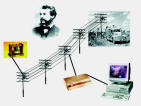Internet Tech
Home
Curriculum Vitae
Interests
Javascript
Internet Technology
"The internet mixes computing and communications tecnology, making information instantly and conveniently accessible worldwide."History of the Internet
 In the late 1960s, ARPA (Advanced Research Projects Agency) of the Department
of Defense developed a means of networking the main computer systems of approximately 12
ARPA funded universities and research institutions. They were to be connected with
communication lines operating at 56kb per second. They called it the ARPAnet...
In the late 1960s, ARPA (Advanced Research Projects Agency) of the Department
of Defense developed a means of networking the main computer systems of approximately 12
ARPA funded universities and research institutions. They were to be connected with
communication lines operating at 56kb per second. They called it the ARPAnet...
Rather than sharing each others computers, as previously intended, the key benefit of this
network was that it allowed researchers to communicate easily and quickly amongst themselves via
electronic mail (e-mail). The primary goal of the ARPAnet was to
allow multiple users to send and receive information at the same time over the same
communications paths (telephone lines). The protocols for communicating over the ARPAnet
became known as TCP (Transmission Control Protocol) and this ensured
that messages were properly distributed from sender to receiver and that those messages arrived
intact.
At this time, organisations worldwide were implementing networks of their own - for communicating
within the organisation and between other organisations and the challenge arose to get these
specific networks to intercommunicate...accomplished with the introduction of the
Internetworking Protocol.....TCP/IP
Initially use of internet limited to universities, research institutions and military before the
government decided to allow access to the Internet for commercial purposes. Businesses began to
realise the superb opportunities provided by the Internet leading to massive investment in its
development.
History of the World Wide Web


The WWW allows computer users to locate and view multimedia based documents on any subject. Although the concept of the internet was conceived in the 1960s, the World Wide Web was developed in 1990 by Tim Berners-Lee of CERN (European Laboratory for Particle Physics). The WWW is distributed over a network of 10 million computers, each of which acts as a web server.
The World Wide Web obeys communications protocol called HTTP (HyperText Transfer Protocol).
Each webpage has a unique HTTP address allowing browsers to retrieve that page
from the Internet.
A URL (Uniform Resource Locator) is another name for HTTP
address i.e. web address. Every website has one and they are split into 3 parts web server name,
directory path, filename.
A typical URL would be as follows: http://www.ucc.ie/registration/index.html
| Protocol: | http:// | ||||
| Domain: | www.ucc.ie | ||||
| Folder: | /registration | ||||
| File: | /index.html |
The domain name helps identify and locate computers on the internet. It acts as an alias to a series of numbers called an IP address.
Although many URLs begin with "www", this is not a necessity as the characters before the first period in the domain name are not part of the registered domain.
Steps in accessing website
- Browser sends a request to DNS
- DNS(Domain Name Server) translates the web servers name into a numeric Internet Protocol(IP) address.Every computer with internet access has a unique IP address and all internet communications rely on this address.
- Request sent from the web browser to the IP address tells the web server at the specified IP address which the web pages is being requested by supplying a directory path and filename
- Browser sends a return IP address so that web server will know where to send the web page
- Text based
- Require a knowledge of HTML
- MS Notepad
- WYSIWYG
- Automated website construction
- Macromedia Dreamweaver and MS Frontpage
A web server is a computer running specialsed software which is always connected to the Internet. When you enter a URL you are sending a request to the server that stores all the requested information to display it the way you want to view it. This computer then "serves" and displays the information via your web browser on your "client" PC.
A website is a directory/folder that is located on the server. Within the site, there may be several folders which contain various sections of the website. It is a collection of webpages.

 A web browser is software that runs on the client PC enabling you to view web pages. They
retrieve documents from web servers and display them on a computer monitor. Examples include:
Netscape Navigator and MS Internet Explorer.
A web browser is software that runs on the client PC enabling you to view web pages. They
retrieve documents from web servers and display them on a computer monitor. Examples include:
Netscape Navigator and MS Internet Explorer.
An Internet Service Provider is used to gain access to the Internet. e.g Eircom, Esat, Indigo
Creating websites
HTML Editors
There are two choices:In the creation of this website I have used the following languages: